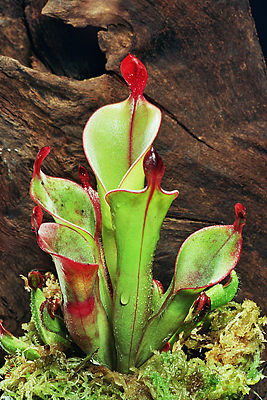Heliamphora chimantensis
| Heliamphora chimantensis | ||||||||||||
|---|---|---|---|---|---|---|---|---|---|---|---|---|

Heliamphora chimantensis |
||||||||||||
| Systematics | ||||||||||||
|
||||||||||||
| Scientific name | ||||||||||||
| Heliamphora chimantensis | ||||||||||||
| Wistuba , Carow & Harbarth |
Heliamphora chimantensis is a carnivorous plant belonging to the genus of the marsh jugs .
features
Heliamphora chimantensis is an herbaceous plant. The tubes are 20 to 35 cm long, in the upper part 3.5 to 5 cm wide and colored green. The upper part of the tubes is completely hairless on the inside. The deep red lid is 1 to 2 cm wide, 2 to 2.5 cm long, spoon-shaped and tapering to a point. On the inside of the lid there are irregularly shaped small glands about 5 mm in diameter. These glands produce a lot of nectar and give off a honey-like scent. At the front of the leaf there is a long V-shaped incision that serves as an overflow for rainwater. Most other Heliamphora species have a hole-shaped opening for this.
The inflorescence has up to 5 flowers and is up to 70 cm tall. The flat seed is about 2 mm long, ovoid and irregularly winged. When spreading through the branching rhizome , the plants form dense, often large colonies that can reach several meters in diameter. It is assumed that the close cohesion of the individual plants, like the alpine cushion plants, creates its own microclimate .
Occurrence and habitat
Heliamphora chimantensis occurs on the Chimantá - Tepui in southern Venezuela in the border area with Guyana . The Chimantá massif consists of eleven table mountains, which are difficult to reach because of their steep flanks. The island-like isolation of the mountains has led to an endemic flora that has only been explored in depth in the past few decades. This vegetation is ombrotrophic , ie dependent on the heavy rainfalls that contribute to the karstification and bog formation on the plateaus. The peat bogs and wetlands are the habitat of Heliamphora chimantensis and numerous other carnivorous plants such as Heliamphora minor and Drosera kaieteurensis .
Heliamphora chimantensis grows in the moist river valleys of the Chimantá massif up to an altitude of 2000 meters. The vegetation here is savanna-like and low and consists of grasses such as Xyris and Stegolepis as well as bromeliads . The nutrient supply in the soil in this area is low. Heliamphora chimantensis prefers sunny locations and forms a plant community with Stegolepis ligulata ( Rapateaceae ), Adenanthe bicarpellata ( Ochnaceae ) and various Brocchinia species (Bromeliaceae).
Hybridization
On Chimantá there is a hybridization between Heliamphora chimantensis and Heliamphora pulchella . Heliamphora pulchella was only described as a separate species in 2005, before that the population on Chimantá was counted as Heliamphora minor .
The hybrids differ from Heliamphora chimantensis in that they have shorter tubes, red veins and coarse bristles inside the tubes. Some of the hybrids show deep red tubes, similar to the shape of Heliamphora pulchella found on Chimantá. The helmet also shows clear influences from H. pulchella .
Systematics
Despite the possibility of hybrid formation between Heliamphora chimantensis and Heliamphora minor , Heliamphora chimantensis is more closely related to the species Heliamphora tatei and Heliamphora neblinae , which occur further south , than to those of the Gran Sabana , in which Chimantá is located. All known species from this region have 10 to 15 stamens , with the exception of H. chimantensis . It has around 20 stamens such as H. tatei and its close relative H. neblinae , which was previously thought to be a variety of H. tatei . H. chimantensis can be distinguished from the two species further south by the length of the stamens. It is only 5 millimeters in H. chimantensis and 7 to 9 millimeters in the other two species.
supporting documents
literature
- Andreas Wistuba, Thomas Carow, Peter Harbarth: Heliamphora chimantensis, a New Species of Heliamphora (Sarraceniaceae) from the 'Macizo de Chimanta' in the South of Venezuela. In: Carnivorous Plant Newsletter. Vol. 31, No. 3, 2002, ISSN 0190-9215 , pp. 78-82, ( online ).
Individual evidence
- ↑ a b c d Andreas Wistuba, Thomas Carow, Peter Harbarth: Heliamphora chimantensis, a New Species of Heliamphora (Sarraceniaceae) from the 'Macizo de Chimanta' in the South of Venezuela. In: Carnivorous Plant Newsletter. Vol. 31, No. 3, 2002, pp. 78-82.
- ↑ Stewart McPherson: Pitcher Plants of the Americas. The McDonald & Woodward Publishing Company, Blacksburg VA 2006 ISBN 0-93992-374-2 , p. 114.
- ↑ Henio Briceño, Carlos Schubert, Jorge Paolini: Table-mountain geology and surficial geochemistry: Chimantá Massif, Venezuelan Guayana shield. In: Journal of South American Earth Sciences. Vol. 3, No. 4, 1990, ISSN 0895-9811 , pp. 179-194, doi : 10.1016 / 0895-9811 (90) 90002-I .
Web links
- Heliamphora chimantensis Pictures, Culture and Description
